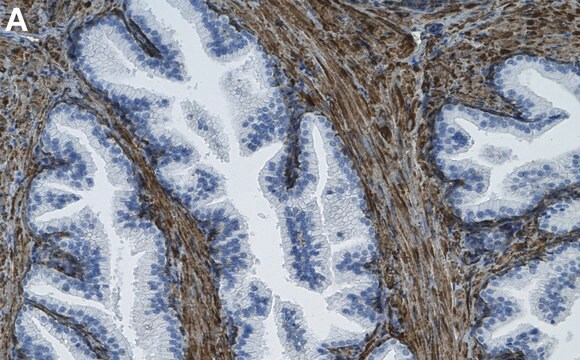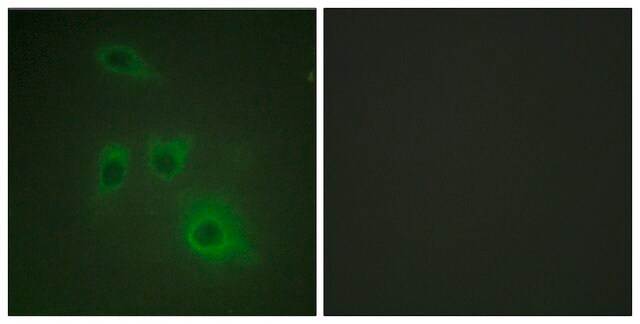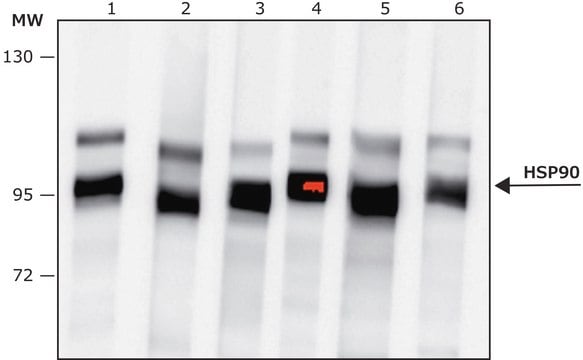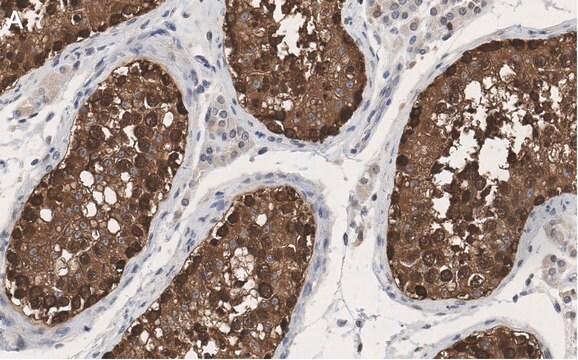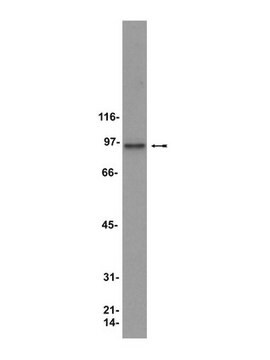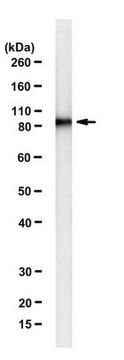General description
We are committed to bringing you greener alternative products, which adhere to one or more of The 12 Principles of Green Chemistry. This antibody is Preservative-free, produced without the harm or sacrifice of animals and exceptionally stable to allow for ambient shipping and storage if needed and thus aligns with "Waste Prevention", "Designing Safer Chemicals" and "Design for Energy Efficiency".
Click here for more information.
ZooMAb® antibodies represent an entirely new generation of recombinant monoclonal antibodies. Each ZooMAb® antibody is manufactured using our proprietary recombinant expression system, purified to homogeneity, and precisely dispensed to produce robust and highly reproducible lot-to-lot consistency. Only top-performing clones are released for use by researchers. Each antibody is validated for high specificity and affinity across multiple applications, including its most commonly used application. ZooMAb® antibodies are reliably available and ready to ship when you need them.
Specificity
Clone 2E21 is a ZooMAb® rabbit recombinant monoclonal antibody that specifically detects HSP90β. It targets an epitope within 16 amino acids from the C-terminal half.
Immunogen
KLH-conjugated linear peptide corresponding to 16 amino acids from the C-terminal half of human HSP90β.
Application
Quality Control Testing
Evaluated by Western Blotting in HeLa cell lysate.
Western Blotting Analysis: A 1:1,000 dilution of this antibody detected HSP90β in HeLa cell lysate.
Tested Applications
Western Blotting Analysis: A 1:1,000 dilution from a representative lot detected HSP90β in Jurkat, SH-SY5Y, NIH3T3, and C6 cell lysates.
Affinity Binding Assay: A representative lot of this antibody bound HSP90 peptide with a KD of 2.6 x 10-6 in an affinity binding assay.
Immunohistochemistry (Paraffin) Analysis: A 1:100 dilution from a representative lot detected HSP90β in Human testis tissue sections.
Note: Actual optimal working dilutions must be determined by end user as specimens, and experimental conditions may vary with the end user.
Target description
Heat shock protein HSP 90-beta (UniProt: P08238; also known as HSP 90, Heat shock 84 kDa, HSP 84,HSP84) is encoded by the HSP90AB1 (also known as HSP90B, HSPC2, HSPCB) gene (Gene ID: 3326) in human. HSP90β, a molecular chaperone, is constitutively expressed in the cytoplasm and promotes the maturation, structural maintenance and proper regulation of specific target proteins involved in cell cycle control and signal transduction. It shares about 95% identity with Hsp90α It maintains the stability and functionality of numerous client proteins in an ATPase-dependent manner. It is known to interact dynamically with various co-chaperones that modulate its substrate recognition, ATPase cycle, and chaperone function. After the completion of the chaperoning process, properly folded client protein and co-chaperone leave HSP90 in an ADP-bound partially open conformation and finally, ADP is released from HSP90 which acquires an open conformation for the next cycle. HSP90 and its co-chaperones are also shown to modulate transcription at least at three different levels (a) by altering the steady-state levels of certain transcription factors in response to various physiological cues (b) modulating the activity of certain epigenetic modifiers, such as histone deacetylases, and (c) by participation in the eviction of histones from the promoter region of certain genes and thereby turn on gene expression. In its resting state, through the dimerization of its C-terminal domain, HSP90 forms a homodimer, which is defined as the open conformation. Upon ATP-binding, the N-terminal domain undergoes significant conformational changes and comes in contact to form an active closed conformation. Following the completion of its chaperoning activity, ATP molecule is hydrolyzed to ADP which then dissociates from HSP90 and directs the protein back to the resting state. This ZooMAb® recombinant monoclonal antibody, generated by our propriety technology, offers significantly enhanced specificity, affinity, reproducibility, and stability over conventional monoclonals. (Ref.: Khandelwal, A., et al. (2018). Nat. Commun. 9; Article 425; Retzlaff, M., et al. (2009). EMBO Rep. 10(10); 1147-1153; Richter, K., et al. (2008). J. Biol. Chem. 283(26); 17757-17765).
Physical form
Purified recombinant rabbit monoclonal antibody IgG, lyophilized in PBS, 5% Trehalose, normal appearance a coarse or translucent resin. The PBS/trehalose components in the ZooMAb formulation can have the appearance of a semi-solid (bead like gel) after lyophilization. This is a normal phenomenon. Please follow the recommended reconstitution procedure in the data sheet to dissolve the semi-solid, bead-like, gel-appearing material. The resulting antibody solution is completely stable and functional as proven by full functional testing. Contains no biocide or preservatives, such as azide, or any animal by-products. Larger pack sizes provided as multiples of 25 µL.
Reconstitution
Reconstitute lyophilized antibody pellet with 25μL of ultrapure water or Phosphate Buffered Saline (PBS). Please refer to our
reconstitution protocol and the specific application guidance on the suggested starting dilutions and sample type.
Storage and Stability
Recommend storage of lyophilized product at 2-8°C; Before reconstitution, micro-centrifuge vials briefly to spin down material to bottom of the vial; Reconstitute each vial by adding 25 µL of filtered lab grade water or PBS; Reconstituted antibodies can be stored at 2-8°C, or -20°C for long term storage. Avoid repeated freeze-thaws.
Other Notes
Concentration: Please refer to the Certificate of Analysis for the lot-specific concentration.
Legal Information
ZooMAb is a registered trademark of Merck KGaA, Darmstadt, Germany
Disclaimer
Unless otherwise stated in our catalog or other company documentation accompanying the product(s), our products are intended for research use only and are not to be used for any other purpose, which includes but is not limited to, unauthorized commercial uses, in vitro diagnostic uses, ex vivo or in vivo therapeutic uses or any type of consumption or application to humans or animals.

